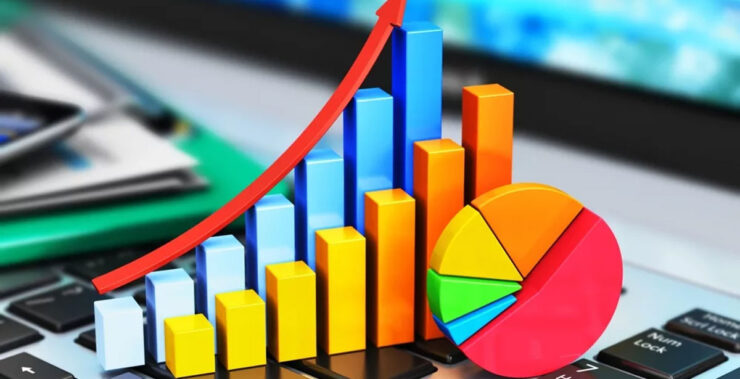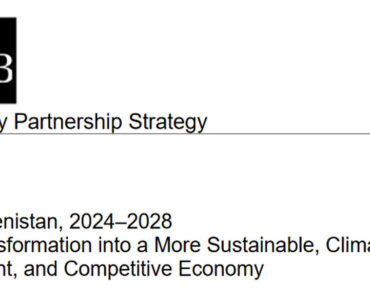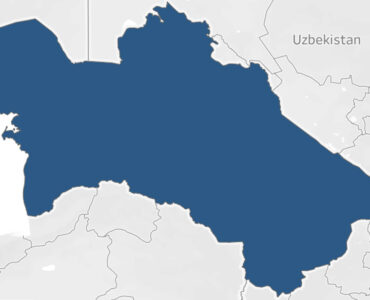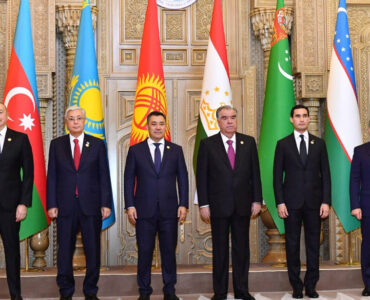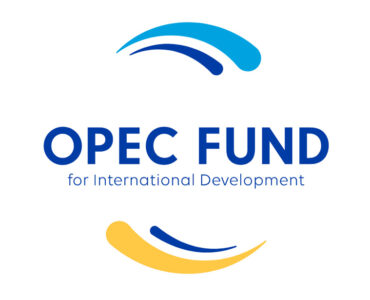Salaries in Turkmenistan are set to increase by 10% starting from January 1, 2024 according to President Serdar Berdimuhamedov’s decree. This once a year, regularly planned raise will include salaries of the employees of the public sector, enterprises, and public associations, in addition to pensioners, individuals receiving state benefits and students on scholarships.
Notably, the government has consistently raised salaries by 10% every year since 2008, which also encompasses a 10% boost in the minimum wage. Prior to 2008, salary increases occurred less frequently, but some were more substantial, such as a 50% raise in 2005 and even a 100% increase in 2003. These were the years during the presidency of Saparmurat Niyazov. However, it is important to highlight that during the mid-1990s, Turkmenistan experienced an inflation rate surpassing 1000%. Salary raises exceeding 100% were crucial to support the welfare of the general population.
Given that salaries have been increased by 10% every year since 2008, questions arise regarding whether it has kept pace with the annual inflation rate during the same period. Turkmenistan’s statistics committee does not publish the inflation rate so we will need to rely on forecasts and data from external sources like the IMF, Professor Steve Hanke, and the Palaw Index. The comparison’s baseline year will be set at 2017, as this marks the onset of the economic challenges that Turkmenistan has been confronting to this day (the Economist, Eurasianet, Human Rights Watch).
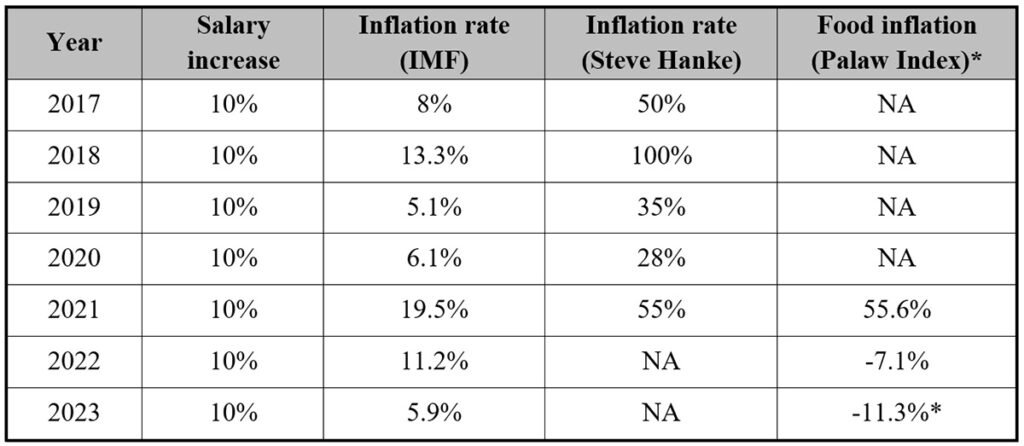
Source: IMF; Steve Hanke; Palaw Index;
*Palaw Index started collecting data from 2021
According to the IMF’s inflation forecasts, the salary increases between 2017 and 2023 appear to be relatively in line with the overall inflation rate. However, it is worth noting that other sources report significantly higher inflation figures for Turkmenistan. Professor Steve Hanke at John Hopkins University has conducted independent measurements of inflation in Turkmenistan for the period between 2017-2021. His findings show significantly higher inflation rates compared to the IMF’s estimates.
Hanke’s data even shows that at one point in June 2018, the inflation rate in Turkmenistan reached as high as 294%. The reason behind these large differences in inflation data lies in Professor Hanke’s methodology. He calculates inflation by monitoring changes in black-market exchange rates and employs the concept of purchasing power parity, which can yield higher inflation figures compared to estimates provided by the IMF.
Turkmenistan’s economy runs on a dual exchange rate system, with an official rate fixed at 3.5 manat/USD since 2015 and a black market rate at 19.5 manat/USD. The government’s strict control on foreign currency exchange in 2016 led to the emergence of the black market. Considering that the black-market rate is 450% higher than the official rate, it becomes increasingly unlikely that the actual annual inflation rate between 2017-2023 remained below 20% as shown by the IMF.
The Palaw Index, a food inflation tracker run by Progres.online, measures food inflation using the ingredients of a staple Turkmen dish, palaw. In 2021, the Palaw Index recorded a significant increase of 55.6% in food inflation. However, it displayed negative values in both 2022 and 2023. This decline in prices during these years can be attributed to the decrease in the black market exchange rate, which fell from its peak of 40 manat in 2021 to 19.5 manat in 2022 and 2023. Nonetheless, prices have remained relatively high due to the lingering effects of the accumulated double and triple-digit inflation rates experienced between 2017 and 2021, as demonstrated by the calculations of Professor Hanke.
Does Turkmenistan have a consumer basket?
The consumer basket is a minimum collection of food products, non-food items, and services essential for maintaining human health and daily life. The Statistical Yearbook of Turkmenistan compiles a list (2017) of items within this consumer basket, such as bread products, potatoes, vegetables, fruits, and meat products among others. It also provides data on the average consumption (2010) per person and calculates the monthly cost for an individual to afford these essential goods. However, it is important to note that the Statistical Yearbook is not available online, and interested individuals must make a formal request to the authorities to access the publication
Does Turkmenistan have a living wage calculation?
Turkmenistan lacks a specific law pertaining to the concept of a living wage. Instead, the government establishes a minimum wage, which has been set at an annual increase of 10% since 2008. Monthly minimum wage in Turkmenistan in 2023 is set at 1160 manat (equivalent to approximately 60 USD by market exchange rate) and it will be raised to 1280 manat (66 USD) from January 2024. Anticipated figures suggest that average salaries in Turkmenistan were expected to rise to 2500 manat in 2023, which translates to approximately 128 USD according to market exchange rates.
To conclude, Turkmenistan’s annual 10% salary increase has yielded mixed outcomes depending on the source of inflation data. While IMF statistics relatively align with the yearly 10% salary raise, figures from Steve Hanke present a contrasting narrative. This underscores the need for greater transparency and economic data from the government. Enhanced openness in providing economic statistics could significantly aid in resolving these discrepancies and better assess the efficacy of these raises in tackling inflation and its impact on the well-being of the population.

